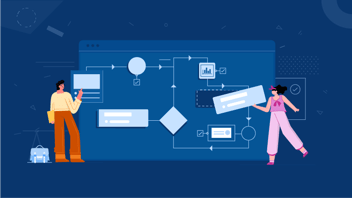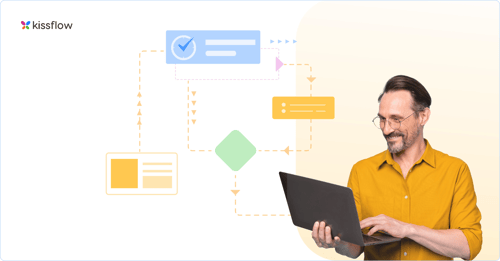
- >
- Workflow Platform >
- Workflow Design That Works in the Real World
Workflow Design That Works in the Real World
During digital transformations, companies face many challenges: resistance to change, lack of visibility into data, and siloed or complex processes. Enterprises can only achieve true digital transformation by carefully connecting siloed processes and transforming them into seamless workflows.
An effective workflow design is the cornerstone of seamless workflows. By incorporating workflow design as a critical part of the digital transformation strategy, CIOs can build more efficient workflows, maximize ROI on technological investments, and drive competitive advantage.
What is workflow design?
Workflow design happens when you map out the sequential tasks involved to take an item from ‘initiated’ to ‘processed’. In the process of workflow design, you get a chance to see the entire process and how data moves seamlessly from step to step.
Each task in the workflow should be assigned to either a single human, group of humans, or to a system.
There’s something essentially business-like about charting a clear, step-by-step path to get something from undone to done. Whether you use charts, whiteboards, a digital workflow design tool, or just the back of a napkin, designing the perfect workflow feels like the core of what a business does.
But while anyone can throw some arrows up on a wall, workflow design must be intelligent to work in the real world. When separated from the realities of the daily grind and multiple priorities, it might seem easy to create workflows. But when regular office life is added back in, the success of your workflow design tool is really tested. In today’s digital era, Business Owners and Managers must embrace automation to stay competitive. A no-code platform enables seamless digital transformation. Learn how Kissflow supports business users.
To show the power of workflow design, let’s look at a typical process that requires a top-notch workflow: employee onboarding.
Onboarding today is simply not cutting it
Employee onboarding may seem like a pretty simple workflow to design, but it’s a classic example of how the ideal can break down in the real world.
Most HR professionals can think through all the things needed to make sure a new employee starts off strong. From a letter from the CEO, to ensuring that a workspace is set up perfectly, to adding email accounts and granting access to essential software, the whole thing seems like it should go pretty smoothly.
Here are some more elements that need to be included:
- Workplace Culture
- Business Motives and Team Goals
- The Workspace
- Policies
- Documentation
- Meet the Team
It’s starting to look a little more complex, but still pretty manageable with workflow design done on the back of a napkin, right?
The dark side of bad workflow design
-
Without a series of set guidelines, there’s no consistency. One HR employee in charge of onboarding may do things ‘their’ style, while another HR team member will have a slightly different approach. This means that the onboarding experience isn’t uniformly good: one day, it might be exemplary. Another day, it might be enough to make someone want to leave immediately.
-
Onboarding can take more time than is really required. When there’s no coordination, there’s no telling when new employees can move from payroll (where they are being coached about salary accounts) to insurance (where a team member is waiting impatiently to set up their company insurance policy). This gap can occur between various steps, and cumulatively add up to multiple lost days.
-
At any given point, finding out where a candidate is maybe a game of educated guesswork. If there’s no set sequence, then there’s no transparency as to what is going on at any given moment.
-
Employees may feel let down if they are shuttled aimlessly between departments. The action-packed first day they looked forward to might turn out to be rather dull. This is a criminal waste when your office is actually an active, busy hub of creativity and excellence.
When you bring workflow design into the picture
Workflow design breaks down your onboarding process into logical steps. When good workflow design enters the picture, onboarding picks itself up from disorganized chaos and lands neatly on orderly productivity. Any stakeholder can track the status of a new joiner’s onboarding process at any given moment. The newly streamlined process can be run efficiently, just by design.
To support effective workflow design, this Power Automate article provides a look into automation-driven layouts.
Advantages of using workflow:
-
Provides a clearly scheduled template for onboarding
-
Reduces time spent on the onboarding procedure
-
Reduces the scope for human error
-
Makes for a consistently good onboarding experience
-
Makes the process clear, transparent, and efficient
-
Reduces the strain on HR
-
Makes onboarding a pleasant experience
To explain how onboarding can change with workflow design, here’s how it works with Kissflow.
How to design an effective workflow
Designing effective workflow uplifts the performance of your processes.
Follow the below-mentioned steps to design a workflow:
-
Outline your tasks that should be completed
-
Identify your resources (input and output)
-
Evaluate sub-workflows involved
-
Find out who is accountable for each step and assign roles
-
Create a workflow diagram to map out the process
-
Implement automation wherever needed
-
Analyze and test the workflow you created
-
Make changes in the workflow depending on the bottleneck
-
Train your team on the new workflow platform
-
Launch the new workflow and keep monitoring for continuous improvement
Incorporating workflow design through Kissflow
Kissflow’s simple low-code platform means that once you’ve used workflow design techniques to break down the process, you can easily build an app to run onboarding that’s perfectly consistent, quick, and efficient.
Design practical and efficient workflows that work seamlessly in real-world scenarios with our workflow software.
1. Create your processes
You can choose to create your own process from scratch using Kissflow’s visual drag-and-drop editor. Alternatively, you can choose a pre-built app from Kissflow’s App Store, and tweak it to your organization’s unique needs.
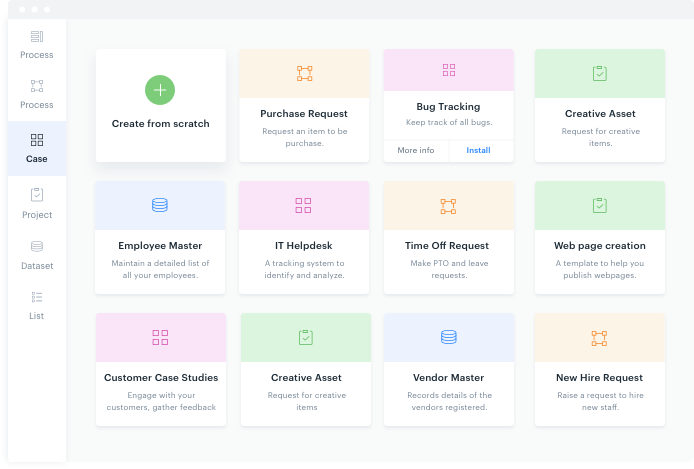
2. Customize your forms
Modify details like data fields, the sequence of tasks, and databases from where the app will pull the required data like employee name, date of joining, and so on.
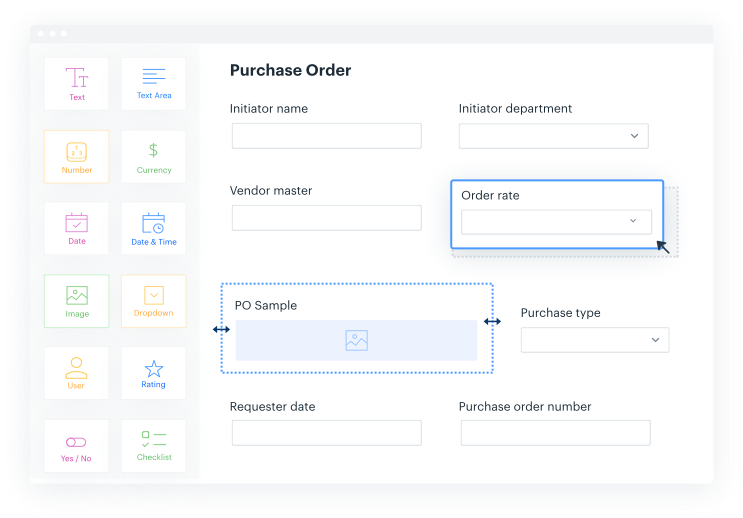
3. Set permissions
Assign stakeholders, the individuals involved in the process, and set roles and responsibilities for all individuals. Define confidentiality settings and control who can initiate the process.
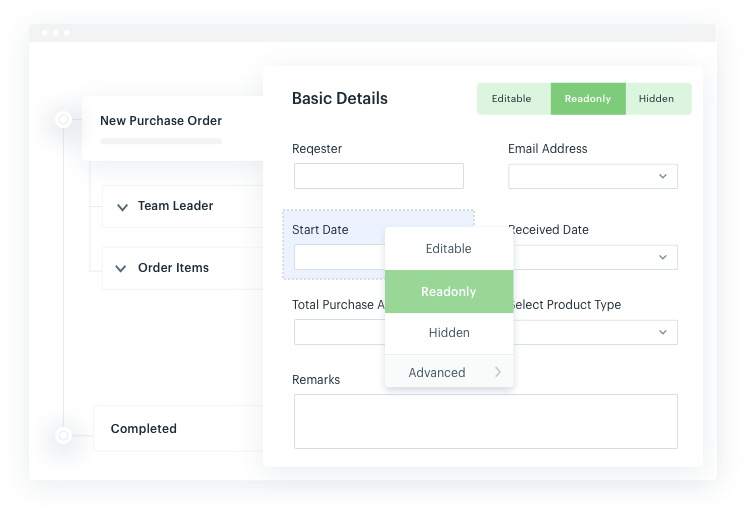
4. Publish your process
Once you’ve created the onboarding process you need, you can share it with your organizations. Call it the end of all onboarding-related email clutter, time delays, and disgruntled new employees!
5. Track Onboarding Progress
You can check the real-time onboarding status of any given employee, whenever you need to. Additionally, you can get one-click visual reports and automated validation.
Solve your workflow challenges with Kissflow and optimize your team's productivity.
Embracing workflow design in the age of automation
With Kissflow’s low-code platform, you can design workflows, create new processes from scratch, or modify existing processes to improve efficiency across the organization.
FAQ - Workflow Design
1. What is a workflow design?
Workflow design is the process of visually mapping out the sequence of tasks, steps, and decisions required to complete a business process. It helps define how work moves from one stage or team to another, ensuring clarity, consistency, and efficiency. A well-designed workflow improves productivity by eliminating bottlenecks and automating repetitive actions, making it easier for teams to collaborate and achieve their goals.
2. What are the 3 basic components of workflow?
The three fundamental components of a workflow are input, transformation, and output. Inputs are the resources or data needed to begin a task. The transformation phase involves processing or actions applied to the input to move it forward. The output is the final result or product of the workflow. These components help define the structure and flow of any process, whether manual or automated.
3. What are the 4 types of workflows?
The four main types of workflows are sequential, state machine, rules-driven, and parallel workflows. Sequential workflows follow a linear progression of tasks. State machine workflows move between different states based on triggers. Rules-driven workflows rely on business rules to decide the flow of tasks. Parallel workflows allow multiple tasks to run simultaneously, improving efficiency in complex processes.
4. What are the 5 steps of workflow?
The five essential steps in a workflow are identifying the process, mapping the workflow, assigning roles, implementing automation, and monitoring performance. First, clearly define the process to be streamlined. Then, map out each task and step involved. Assign responsibilities to relevant stakeholders, automate where possible, and continuously monitor the workflow to identify improvements and optimize performance.
5. What are the key principles of effective workflow design?
Key principles of effective workflow design include starting with clear objectives, minimizing handoffs between people or departments, building in appropriate automation, creating clear exception handling for non-standard cases, ensuring visibility into status at every stage, incorporating feedback mechanisms, designing for adaptability to changing conditions, and focusing on the end-user experience rather than just technical functionality.
6. How does automation improve workflow design?
Automation improves workflow design by handling routine decisions through business rules, eliminating manual handoffs that cause delays, providing real-time visibility into bottlenecks, standardizing execution for consistency, enabling data-driven refinements through performance analytics, supporting exception handling through intelligent routing, and freeing knowledge workers to focus on tasks requiring human judgment.
7. What industries require advanced workflow design?
Industries requiring advanced workflow design include insurance (complex claims processing), legal services (case management), healthcare (patient care coordination), pharmaceutical (clinical trials management), aerospace (engineering change management), and financial services (mortgage origination). These sectors manage complex, knowledge-intensive work with significant regulatory requirements and multiple stakeholders.
8. What tools help design efficient workflows?
Tools that help design efficient workflows offer visual drag-and-drop interfaces, pre-built templates for common scenarios, role assignment capabilities, notification and reminder systems, performance analytics identifying bottlenecks, mobile accessibility for on-the-go participation, and integration capabilities with existing business systems. The best solutions offer both structure and flexibility.
9. What are common mistakes in workflow design?
Common mistakes in workflow design include creating overly complex flows difficult for users to follow, failing to handle exceptions and edge cases, insufficient stakeholder involvement leading to impractical designs, automating broken processes without optimization first, neglecting to build in appropriate notifications and visibility, creating bottlenecks through unnecessary approval steps, and designing for current rather than future needs.
Streamline your workflow and achieve more!
“Creating workflows is significantly easier here than in other products. We have been able to successfully distribute the work to create workflows because of Kissflow”
- Ryan H
Thanks for submitting.
Our solution experts will connect with you to get started.
Related Articles


